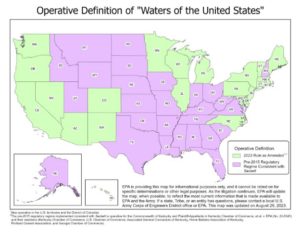By RALPH A. DEMEO AND
STEPHEN L. SPECTOR
Water is the driving force of all nature. No matter who we are or where we come from, there is one unifying fact about water – every person, animal, and plant must consume water to survive. Over the last 100 years, states, counties, and municipalities across this United States have developed public water systems (PWS) that provide easy access to safe drinking water for the public. The instructions are simple: turn on the tap, fill up the glass, and drink.
We have an expectation that there will always be an abundant and continuous source of drinkable water. In reality, safe drinking water is a resource we take for granted. Unfortunately, because of industrial and commercial activity over several decades, harmful contaminants have become more prevalent in PWS water sources.
To combat this growing crisis caused by one particularly incipient suite of chemical, per- and polyfluoroalkyl substances, or PFAS. PFAS is a class of chemicals known as “forever chemicals” because they are incredibly resilient and do not break down naturally. They are often used to repel oil and water, and resist heat, being used in products such as nonstick cookware, stain-resistant clothing, firefighting foam and other products.
In 2023 the Biden Administration and the United States Environmental Protection Agency (EPA) developed the PFAS Strategic Roadmap (Roadmap), laying out a long-term comprehensive plan to reduce PFAS in drinking water to levels that do not pose health risks to the public. On April 10, when the EPA announced the final National Primary Drinking Water Regulation (NPDWR) for six PFAS constituents in drinking water. Once implemented, this final rule creates legally enforceable Maximum Contaminant Levels (MCLs) for the six PFAS in Community Water Systems and Non-Transient Non-Community Water Systems, collectively referred to as PWS.
So what does this regulation mean for Florida?
The final EPA PFAS rule sets MCLs at 4.0 parts per trillion for PFOA and PFOS, which are the most prevalent of the six PFAS. This standard is intended to reduce exposure from these PFAS in drinking water to the lowest levels that are feasible for effective implementation.
However, most water quality and environmental laboratories do not have equipment sensitive enough to detect at this extremely low level. Furthermore, if remediation were to be required, which is likely, there is no generally accepted method for cost-effectively remediating PFAS. While many companies are rapidly evaluating and proposing new technologies, carbon filtration is the generally accepted method. This is very expensive and time-consuming, taking perhaps decades to achieve the regulatory standard. There is also a problem with how to dispose of the filters once spent.
Adding to the challenge, on April 19, the EPA issued a final rule listing PFOS and PFOA constituents as “hazardous substances” under the Comprehensive Environmental Response, Compensation, and Liability Act, 42 U.S.C. Section 9601 et seq., which will dramatically increase liability and remediation costs. This final action will address PFOA and PFOS contamination by enabling investigation and cleanup of these harmful chemicals and ensuring that leaks, spills, and other releases are reported. In addition to the final rule, EPA is issuing a separate CERCLA Enforcement Discretion and Settlement Policy. The Policy provides enforcement criteria that will inform EPA’s decision on whether to pursue potentially responsible parties from response actions or costs under CERCLA to address the release or threatened release of PFAS. It clarifies when EPA intends to use CERCLA as an enforcement mechanism, or whether to pursue a particular party.
The EPA believes that it has set reasonable time frames for PWS to comply with the MCLs in their drinking water. The final rule requires: • PWS must monitor for these PFAS and complete initial monitoring (by 2027), followed by ongoing compliance monitoring. PWS must also provide the public with information on the levels of these PFAS in their drinking water beginning in 2027. • Public water systems have five years (by 2029) to implement solutions that reduce these PFAS, if monitoring shows that drinking water levels exceed these MCLs. • Beginning in five years (2029), PWS that have PFAS in drinking water which violates one or more of these MCLs must take action to reduce levels of these PFAS in their drinking water and must provide notification to the public of the violation.
The Florida Department of Environmental Protection (FDEP) is expected to begin rulemaking now that the federal rule is in place. In Florida, federal MCLs adopted by EPA apply to all potable groundwater by law. Currently, FDEP regulations require that groundwater be free from any contaminants that are harmful to plants, animals, and humans; are acutely toxic; pose serious threat to the public health, safety, or welfare; create a nuisance; or impair the beneficial use of adjacent waters. It is likely FDEP follows the EPA in proposing to adopt the federal standard. However, based on 2022 Florida legislation championed by many stakeholders, including ports, airports, landfills, local governments, and others, FDEP must report to the Florida Legislature in January 2025 with its proposed PFAS standard.
The EPA estimates that compliance with its rule will cost approximately $1.5 billion annually. This is probably a very conservative number given the prevalence of the so-called “forever chemical,” which is also increasingly shown to be the “everywhere chemical.” Who will fund these costs is still unsettled, but it will likely require both private and government funding.
The Biden Administration has allocated $9 billion from the 2021 Bipartisan Infrastructure Law to help communities affected by PFAS pollution in their drinking water. The law also makes another $12 billion available for general drinking water improvements, including funds to local communities with PFAS contamination. However, this still leaves unsettled what to do about the many thousands of contaminated sites that may not be public water systems, not to mention the likely personal injury claims associated with exposure to these chemicals.
To conclude, facilities which have or are likely to have PFAS contamination would be wise to start planning immediately for the almost inevitable wave of regulatory and private action that is coming soon, including likely litigation. It starts with testing areas of known or suspected PFAS contamination. This includes public water systems, airports, fire departments, wastewater treatment plants, landfills, and other facilities.
In short, it is PFAScalypSe Now! ●
Ralph A. DeMeo is a Shareholder and Stephen L. Spector is a Senior Associate for Guilday Law Firm in Tallahassee











